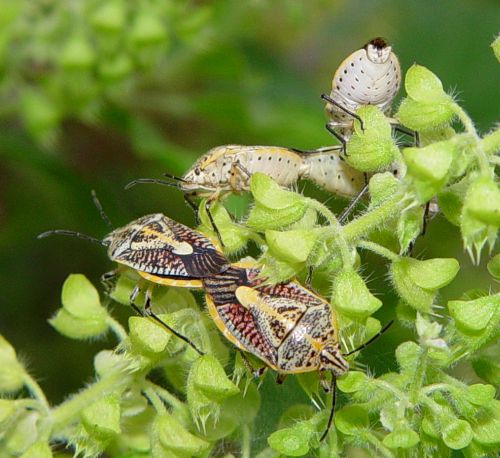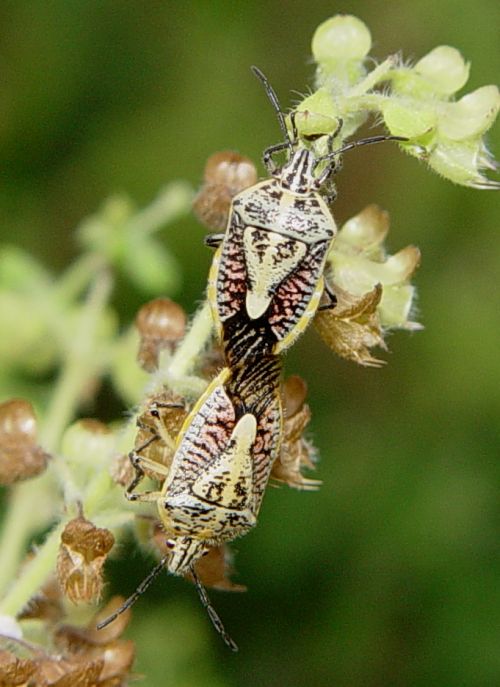 |
|
|
Agonoscelis nubilis (Fabricius, 1775) |
|
|
|
Cimex nubilis Fabricius, 1875: 712. Halys nubila: Fabricius, 1803: 183. Pentatoma grata Palisot de Beauvois, 1811: 129, pl. 9 fig. 5. (syn. by Stål, 1876) Aelia nubila: Hahn, 1836: 29-30, fig. 251. Agonoscelis indica Spinola, 1837: 329-330. (syn. by Dallas, 1851) Aelia crucifera Westwood, 1837: 8, 32. (nomen nudum; syn. by Stål, 1862) Nevroscia grata: Amyot & Serville, 1843: 109-110. Nevroscia nubila: Amyot & Serville, 1843: 110. Agonoscelis nubila: Herrich-Schäffer, 1844: 107. Nevroscia sulciventris Ellenrieder, 1862: 144-146, pl. 2 fig. 11. (syn. by Stål, 1876)
|
|
Distribution:
China (Fujian, Guangdong, Guangxi, Guizhou, Hainan, Hunan, Jiangxi,
Sichuan, Xizang, Yunnan, Zhejiang), India (Bihar, Jammu & Kashmir,
Karnataka, Madhya Pradesh, Maharashtra, Meghalaya, Orissa, Tamil Nadu, West
Bengal), Indonesia (Java, Sumatra), Japan (Okinawa), Macao, Malaysia
(Malaya), Myanmar, Pakistan, Philippines, Ryukyu Islands, Sri Lanka, Taiwan,
Thailand, Vietnam. |
|
|
Type Material:
Cimex nubilis Fabricius, 1775: STS (5): South Africa [in
error?], BMNH (1♂), ZMUC (4 in Kiel collection). Pentatoma grata
Palisot de Beauvois, 1811: ST(S): Saint-Dominigue [= Haiti; in error],
deposition unknown. Agonoscelis indica Spinola, 1837: STS (♂,
♀): Bombay [India], MRSN (Casale, 1981, did not list any specimens of this
species). Aelia crucifera Westwood, 1837: STS: Caput Bonae
Spei [= South Africa; in error?], Java, Brasilia [in error?], OXUM.
Nevroscia sulciventris Ellenrieder, 1862: ST(S): Sumatra
[Indonesia], Lahat, deposition unknown. |
|
Note: Westwood (1837) did not provide a description of Aelia crucifera; he only gave a couple localities and then speculated that it may in fact, only be a variety of nubilis.
|
|

Photo by Victor Gapud (see below)

Photo by Victor Gapud (see below)
Photo information: The three photos on this page were taken by Dr. Victor Gapud, University of the Philippines, Los Banos, Philippines. They were taken around the 20th of October, 2005 in the Institute of Plant Breeding garden on the UPLB campus. He indicated that the plant hosts were Ocimum basilicum (sweet basil) and Osimum tenuiflorum (holy basil), and that there were numerous individuals on the reproductive parts of the plant.
| Researchers | Genus Index | Systematics | Host Information |
| Bibliography | Species Index | Biographies & Type Info | Natural Enemies |
| Catalogs | Identifications | Collection Lists | Other resources |
|
|
David A. Rider
Professor of Entomology
North Dakota State University
202 Hultz Hall
Fargo, ND 58105
E-Mail:
David.Rider@ndsu.edu
Published by the
Department of
Entomology
Prospective students may schedule a visit by calling 1-800-488-NDSU.
